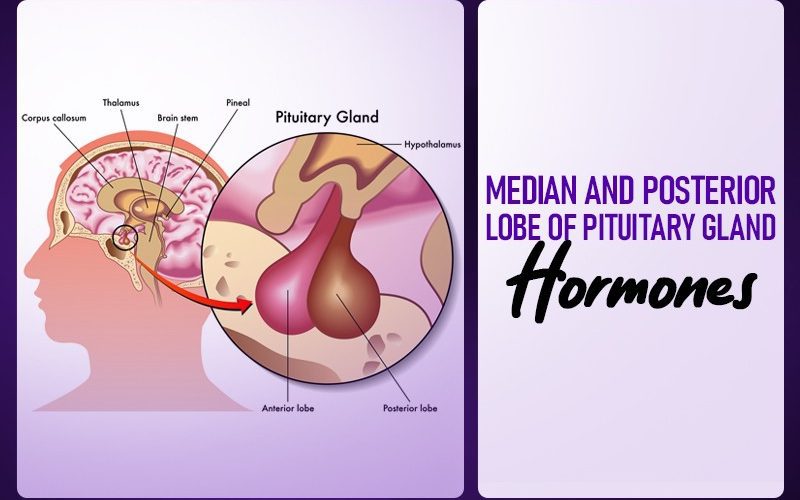Median And Posterior Lobe Of Pituitary Gland- Hormones. Last time we discussed the anterior lobe of the pituitary gland, today we will discuss the median and posterior parts.
Hormones secreted by these parts and the result of their hyposecretion and hypersecretion.
All will be discussed here.
Median Lobe
This part is not very prominent in humans.
It is a thin layer of cells present between the anterior and posterior lobe.
Median lobe produces melanocyte stimulating hormone which is regulated by hypothalamic melanocyte stimulating hormone inhibitory hormone.
This hormone increases in humans during pregnancy to stimulate the production and release of melanin in skin and hair.
Posterior Lobe
This part does not synthesize any hormone by itself and is made up of axons and neurosecretory hormones of hypothalamus.
Antidiuretic Hormone/Vasopressin
This part stores antidiuretic hormone alongwith oxytocin.
Antidiuretic hormone is released in the state of dehydration, decreased blood volume, and low blood pressure.
Under secretion of this hormone causes diabetes insipidus which is characterized by excessive production of diluted urine and frequent thirst.
Over secretion leads to kidney problems.
Oxytocin
It is released during childbirth and in nursing women.
During childbirth, it is released in waves that helps in contraction.
Over secretion leads to the rupture of the uterine wall.
Under secretion leads to the inhibition of normal childbirth process.
In lactating women, suckling causes the release of oxytocin and causes dilation of milk ducts in the mother while promoting the milk ejection.
Thyroid Gland
This gland is composed of two lobes that are present at both sides of the trachea.
Thyroid gland produces three active hormones- triiodothyronine (T3), tetraiodothyronine (T4, and also known as thyroxine), and calcitonin.
Triiodothyronine And Tetraiodothyronine
The names indicate that T3 contains three iodine atoms while T4 contains four atoms of iodine.
TSH from anterior pituitary stimulates the production of these hormones.
These hormones promote basal metabolic rate of the body.
They enhance glucose catabolism and synthesis of cholesterol in the liver.
They promote development of the nervous system in infants and fetus.
T3 and T4 also act on muscles for their development and functioning while promoting growth and maturation of the skeleton.
And they promote normal motility and gastrointestinal tract.
Over secretion of these hormones causes Grave’s disease.
While under secretion in adults causes myxedema which is characterized by low metabolic rate, puffy eyes, feeling chilled, thick, dry skin, hair loss, and enlarged thyroid gland.
Myxedema may result due to low iodine consumption through diet.
Under secretion in infants leads to cretinism which is characterized by mental retardation, poor physical growth, and disproportionate body size.
Bone maturation and puberty are severely delayed.
Calcitonin
Median And Posterior Lobe Of Pituitary Gland- Hormones. Excessive level of calcium in blood stimulates the release of calcitonin while declining calcium level in blood inhibits its secretion.
This hormone increases the deposition of calcium in the bone matrix.
It inhibits calcium absorption by intestine and decreases its reabsorption by kidney .
Calcitonin is ore important in childhood when bones are maturing and increasing in size.
Deficiency of calcitonin leads to calcium not absorbing in bones, which further leads to the dysfunctioning of muscles and nervous system and may lead to kidney stones.




Leave A Comment